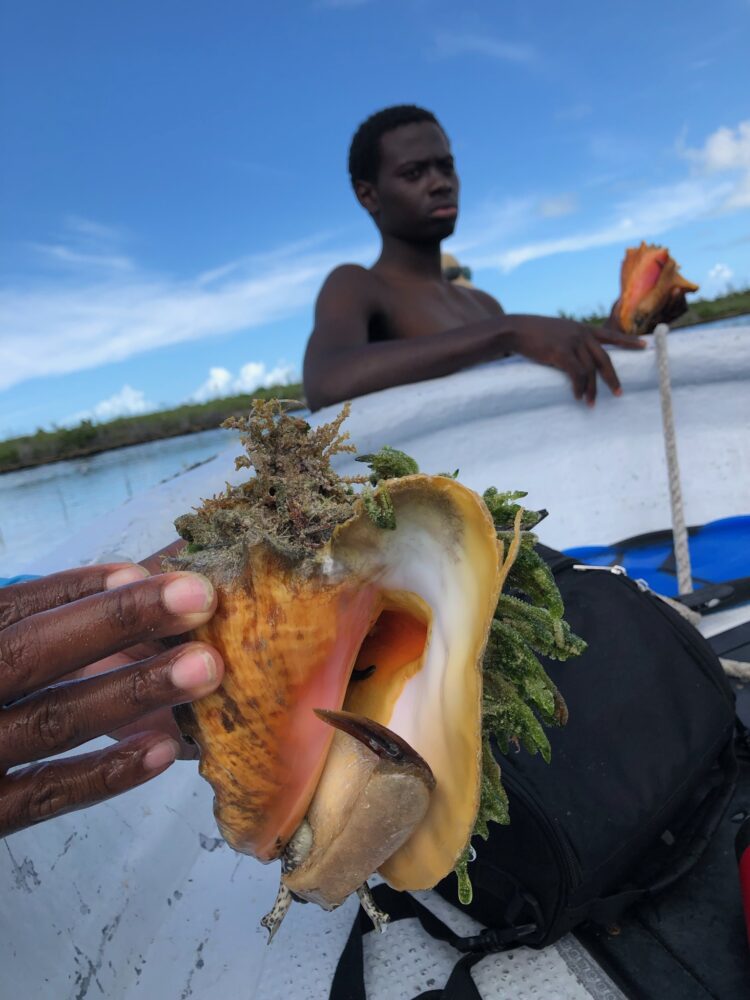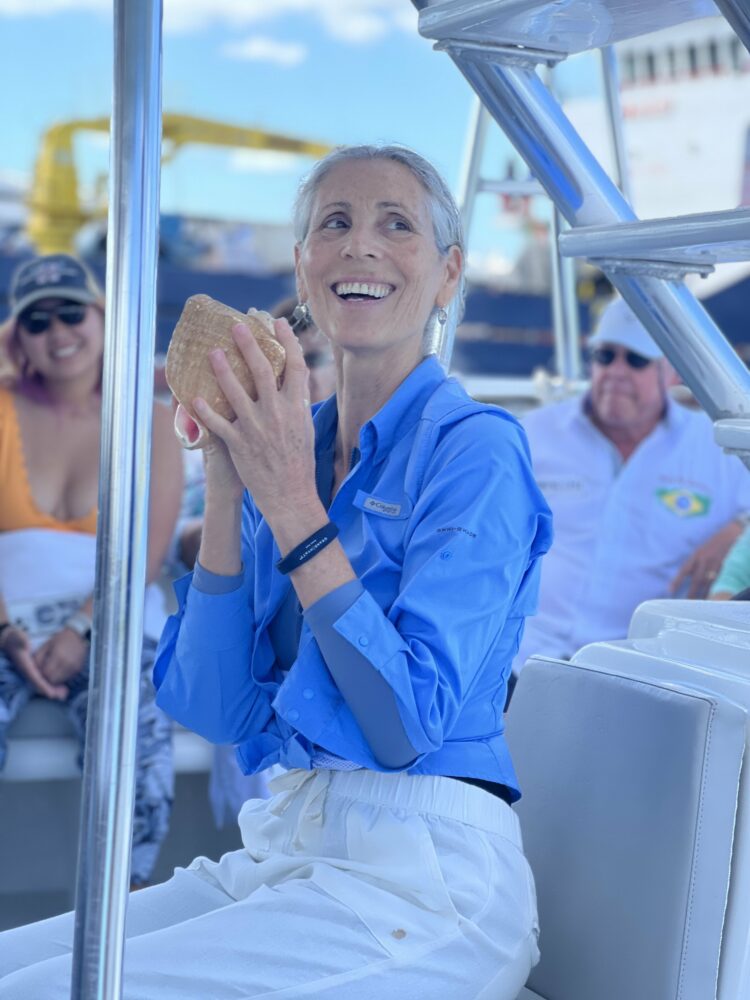
It was almost inevitable that Megan Davis was going to become a marine scientist. She moved from Australia to Florida as a child and spent her summers sailing the Bahamas with her family.
And her teenage adventures sparked a love affair with the queen conch, an herbivore gastropod that’s endemic to the Caribbean and Florida. Four decades later, Davis is still head over heels. “It’s my first love,” she says, holding up a giant queen conch shell to her cheek and smiling. “And my strongest love, probably.”
The queen conch is a Caribbean icon. It’s distinctive thanks to its long eye stalks that can move independently, and tube-like mouth that can pull into its shell if threatened. They’re also large – weighing up to five pounds and growing up to 12 inches – and they can live until they’re 30.

It’s a culturally important species – used in recipes, for jewelry making, and to provide a stable income.
“I don’t know what The Bahamas would be without conch,” says Raveenia Roberts-Hanna, president of The Bahamas Agriculture and Marine Science Institute. “It’s a piece of ourselves, and it’s important we preserve it. It’s ingrained into our culture in every aspect – we eat the meat; the shell is used for crafts.” Conch, Roberts-Hanna explains, is the main protein source for islanders aside from chicken. It’s also an important source of income for many people – exports are believed to bring in $3.3 million a year.
As with many endemic marine species, the queen conch is under threat. Seagrass, which it relies on for food and shelter from predators, is declining due to pollution, dredging, oil spills, sea level rise and an increase in severity of tropical storms. In 2024, the US government listed the species as threatened – although not currently in danger of extinction, it is likely to become so within the foreseeable future, the NOAA wrote in its decision. The conch’s nursery grounds are in shallow areas, and so they are incredibly vulnerable when hurricanes hit. There are between 743 million and 1.4 billion conch left in the wild. That might sound like a lot but in some areas of the Caribbean the population has declined by 91%.
Part of the problem is that conch take three to five years to sexually mature – something Davis has sought to educate the public about for her entire career.

When Davis was 21, she moved to the Turks and Caicos Islands. “I knew about conch, I knew about aquaculture – I’d been studying it, but I hadn’t really done the hands-on work,” she explains. Davis had the opportunity to be part of a small experimental aquaculture project in the region that was developing conch farming. “I was able to be one of the pioneers with a group throughout the Caribbean who were beginning to understand and work with conch.”
Eventually, aged 23, Davis co-founded the world’s only production-scale conch farm – which was able to grow 1 million conch every single year, and operated for several decades. “Once we went to a commercial level, we were able to grow the species in really large numbers,” she explains. “So, the work we did back then is now the work we use today.”
Davis spent 10 years at the farm, before joining Florida Atlantic University and opening the Queen Conch Lab in Fellsmere, Florida, which she still helms today. Davis, who holds a PhD in biological science, has since designed and opened six mobile and stationary conch hatcheries across the Caribbean to hatch and grow juveniles “for the sake of the species, the ecosystem, and the people who depend on the fishery.” The projects are still in their infancy and the farms are just beginning to release conch.

Davis is passionate about working with local fishermen, and plans to roll out more community partnerships in the near future. In Puerto Rico, for example, a partnership project with FAU, Conservación Conciencia and the Naguabo Fishing Association pays fishermen to help co-manage the species. “They tell us that when they see a female laying her eggs they leave her alone, instead of fishing her,” she says. “They are thinking ahead about the future of the species. It really brings the true meaning of sustainability.”
Davis hopes that one day fishing communities will get more involved in raising conch, either in co-management of the fisheries or even having their own pens where they can raise conch themselves. “We have lots of ideas,” she says excitedly.
Even though Davis has spent the majority of her life studying conch, she’s still working hard to realize her vision: a queen conch farm in all 13 Caribbean countries. So far, Davis and her team have partnership projects in six: The Bahamas, Jamaica, Curacao, Bonaire, St Vincent and the Grenadines, and Turks and Caicos Islands. They anticipate launching at least two new projects every year.

Another important part of her work involves disseminating her knowledge to the Caribbean community. “We help communities understand the animal. Its life cycle, when they’re sexually mature and when to harvest them, understanding that the breeding colony needs a certain amount of conch to breed.” When Davis and partners hire staff from the local community, some of them won’t have any science background, and so are trained to be conch aquaculturists. Puerto Rico, she says, is a prime example of how the project incorporates the community. “There, we have fishers working with us, their wives work with us, and their children come in for internships.”
The scientist, who just turned 65, is now in the legacy years of her career and feels it’s more important now than ever to train people in their communities. Davis and her team are spreading awareness and education through the creation of manuals, videos and an online course. “We’ve been able to make it accessible to so many people, we’ve gone into these communities and left this information in their hands.
“It means the knowledge won’t be lost. It won’t bring back all the conch, but we have to make sure that we know how to work towards the survival of the species for the future.” ◼



